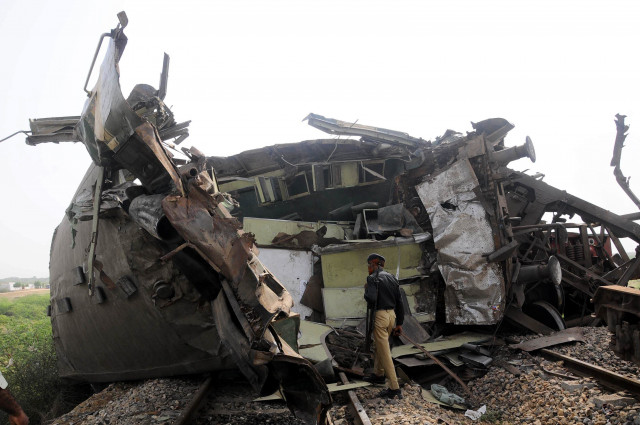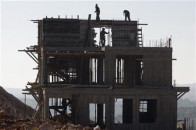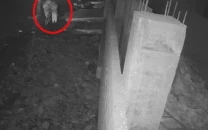Blood on the tracks as Karachi-bound trains collide
Merged Millat, Karachi Express were waiting for green light to enter the station when Shalimar Express rammed into it.

Two people were killed and nine others injured when the Karachi-bound train, Shalimar Express, rammed into the Millat Express at Ghaggar Phatak in Bin Qasim Town early Monday.
Around 52 kilometres outside the city, the railway tracks were strewn with the twisted metal of the remains of the coaches and engine. Residents, who were watching the rescue work, said that they were woken up by a sickening crash at 3:20 am.
According to Pakistan Railways officials, the two Karachi-bound trains - Millat Express and Karachi Express - were amalgamated and were running on one engine. They were waiting for the Operational-373, the approval to enter a station, at Ghaggar Phatak, when another Karachi-bound train, the Shalimar Express, hit them from the back, throwing the last two coaches off the tracks. At least three bogies were destroyed.
Security guard Ali Asghar and an unidentified passenger died. Fortunately, the coaches were laden with luggage and the train’s electricity plant, which means there were fewer passengers than usual. There were about 700 passengers on the Millat and Karachi Express and 550 passengers on the Shalimar Express.
According to Pakistan Railways deputy engineer Sameenullah Gandpur, the trains’ movements are operated with an auto-block system and at Dhabeji Railway Station the signal was red, which means that the driver of the Shalimar Express should have slowed down. He didn’t which is why he hit the Millat Express. “Perhaps the driver was sleeping,” he speculated, adding that this is one of main reasons why a driver can miss a signal.
In the searing heat, labourers from the railway department removed the metal, with a 1930-British era steam crane doing most of the work. The tracks and the coaches were smeared with red as material from some drums on board were damaged. Men tried to move the jammed wheels of the engine of the Shalimar Express.
The engine destroyed in the accident is said to be worth Rs300 million. The engine that was damaged was one of the 10 finest engines in the Pakistan Railways, explained Divisional Commercial Officer Shoaib Adil. It took 11 hours to clear the way. The schedule for several services was disrupted and the trains which were reaching Karachi from Lahore among other cities were stopped at nearby stations.
Within three hours of the accident, the passengers were dispatched on night coaches for their destinations, while the injured were taken to Jinnah hospital. They were discharged after being treated for minor injuries. The driver of the Shalimar Express ran away.
“It seems that the driver is responsible for the incident but we have not yet arrested him and police is trying to find him,” said Muhammad Khalid, a federal inspector who came from Lahore to investigate. Khalid added that they would start the case within seven days as is laid down in PR procedure. A notice will be published in newspapers to ask witnesses to come forward.
Karachi Divisional Superintendent Syed Anzar Ismail Rizvi told The Express Tribune that the guard’s family will be given compensation according to the Prime Minister’s package, which includes a sum of money between Rs300,000 to Rs1 million, a job for one of his sons in the PR and free education for a son till the intermediate level. “We cannot estimate the financial loss at the moment,” Rizvi added. “However, the engine of the Shalimar Express was a powerful engine.”
According to PR DSP Mohammad Ali Dahri, the FIR was registered at Steel Town police station and the driver and fireman of the Shalimar will be included in the investigation. The charges include negligence and carelessness, damage to property and causing death by reckless driving.
Published in The Express Tribune, September 18th, 2012.



















COMMENTS
Comments are moderated and generally will be posted if they are on-topic and not abusive.
For more information, please see our Comments FAQ